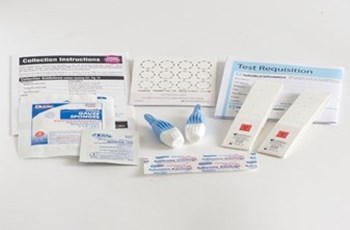
The current concern over the dangerous Ebola virus has heightened awareness about infections that can be transmitted via contact with body fluids.
The last thing we want is to be exposed to body fluids from others infected with dangerous organisms and, ironically, a likely place to encounter such fluids is the phlebotomy station at the doctor’s office.
How can exposure to other people who may be sickened with an infectious agent be minimized?
One way to minimize exposure is to use at-home sample collection methods, a hallmark of ZRT lab testing, which ensure seclusion and don’t require samples to be handled around other patients. That keeps risk of passing on infections such as Ebola to a minimum, since no blood is drawn and transferred to tubes at the doctor’s office, and no wet urine or saliva is handled or collected except at home.
Self-sampling at home is not only simple and convenient, it is in fact essential for capturing the waking saliva sample for a diurnal cortisol assessment, the first-morning urine void for accurate testing of night-time melatonin production, or a fasting sample for insulin assessment. Patients can eat breakfast and get ready to start their day while blood spot and urine samples dry before mailing off to the lab.
Drying blood spot and urine samples for shipment to the lab ensures that most pathogens are inactivated – transmission of infections, particularly viruses, requires contact with a liquid body fluid. Enveloped viruses, which have a protective lipid envelope covering the protein capsid (the infectious part of the virus), are particularly sensitive to drying compared to non-enveloped viruses; Ebola is an enveloped virus. A dry sample therefore carries very minimal (almost zero) risk of infection while it is en route to the lab.
What about exposure of lab personnel once samples arrive for testing?
The laboratory at ZRT is CLIA-certified, requiring documentation of, and adherence to, exacting procedures for testing*. Safety procedures include requirements for safe handling and disposal of chemicals used for testing, and the control of any pathogens (disease-causing organisms) that are transmitted via contact with body fluids.
At ZRT, we closely follow the guidelines for blood-borne pathogen exposure control as outlined by the Occupational Safety and Health Administration’s standard 29 CFR 1910.1030. These require laboratory personnel to wear personal protective equipment (PPE) when handling any biological samples, proper disposal of samples to prevent any infection risk to laboratory and non-laboratory personnel, and cleaning of all work surfaces and equipment that may come into contact with biological samples to prevent any spread of infectious agents.
The best disinfectant that is active against the widest range of infectious agents, including both enveloped and non-enveloped viruses, is a bleach (sodium hypochlorite) solution. However, guidelines issued by OSHA, the CDC, and the WHO all emphasize that bleach solution must be prepared fresh daily otherwise it loses potency as the chlorine slowly evaporates. At ZRT, a 10% bleach solution is prepared fresh every day for routine disinfection of work surfaces and lab equipment.
ZRT – an innovator in testing of samples collected at home
ZRT is committed to improving the health and wellness of people who test with us, not only with reliable, accurate test results but by ensuring that people can collect samples simply and conveniently in their own homes. A pioneer of lab testing using at-home collection methods, ZRT has offered commercial testing in saliva since 1998, in dried blood spot since 2004, and in dried urine since 2013. We are currently the only commercial lab offering testing in all three mediums sampled at home.
*Standard Operating Procedures at ZRT are reviewed, updated, and re-approved at least annually, and these cover the methods used for testing, the quality control of all assays, sample processing procedures including criteria for sample rejection and storage as well as adherence to HIPAA regulations, regular calibration and maintenance of all laboratory equipment, and of course strict guidelines for safety of lab personnel.
Resources:
